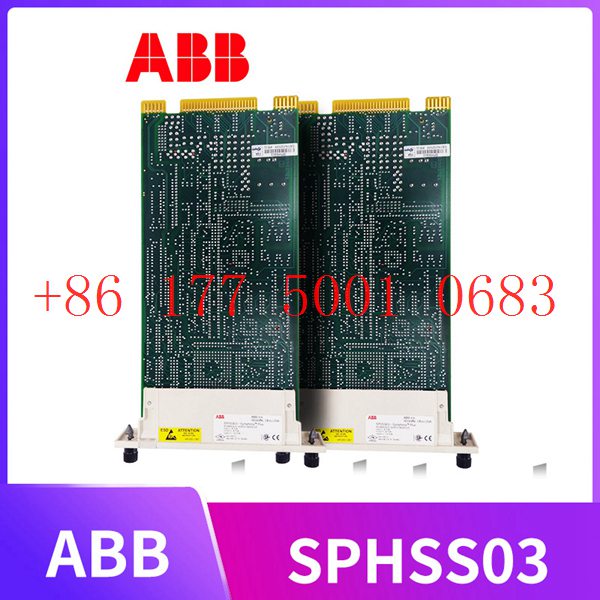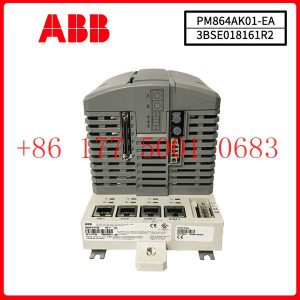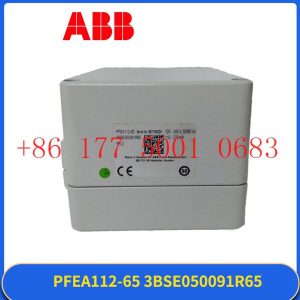Description
hardware flow control. It is an ideal choice in the field of industrial automation.
Although it was established only a few months ago, ABB Future Lab has already cooperated with Huawei to
complete the AI training of garbage sorting robots in two months. This robot uses AI technology based on Huawei
chips and uses industrial cameras to sort objects.
Obviously, adjusting the business model and organizational structure is an important reason why ABB has
lways been at the forefront of the industry.
From technology iteration to application implementation, ABB aims to provide complete solutions
As a pioneer in manufacturing automation and digitalization, ABB”s products in the automation field are constantly
improving, and its application industries are also expanding.
In Alf”s view, the structure and construction of automation have not changed much in the past 30 years. From signal
collection and information transmission to work scenarios or operational interfaces, the flow of information in automated systems has basically not changed.
But the arrival of 5G may change the way information is transmitted between devices. 5G’s characteristics such as large
capacity, high reliability and low latency make it possible to realize independent connections between devices. If real-time
mainline connection can be achieved and installed on the cloud or platform, it will be a more disruptive application.
5G will not only change the way ABB operates, but is also likely to introduce digitalization into the industry, including digital
operation and maintenance. ABB has launched an industrial Internet solution called ABB Ability, which firstly provides a platform
, and secondly, it includes all ABB”s digital cloud products, such as equipment industrial solutions and transportation solutions.
In addition to digitization, another focus of Alf is the autonomy of machines. He took the autonomous management of
autonomous driving and warehousing as examples to think about the development process of machine autonomy –
from human operation to machine operation, and ultimately to autonomous implementation and testing without the need for humans at all.
For ABB, in addition to popular autonomous driving technology, industrial production scenarios also have strong
demand for the autonomy of machinery and equipment, such as autonomous docking of ships and the mining industry
. In some industrial scenarios represented by mining, toxic gases and substances in the working environment are
harmful to the human body, so equipment
is required to have the ability to enter and leave the mine independently. ABB first needs to study the value proposition
of these businesses, discover potential applications, and then discover in which fields it can be applied.
A technology close to autonomy is artificial intelligence. Since its birth in the 1960s, it has been attracting people”s
attention, and there have been endless discussions about “robot replacement”. After decades of development,
related technologies have gradually matured, and more and more AI technologies have begun to be discussed
in the application field. The products and technologies
of leading manufacturers such as ABB have attracted much attention.
ABB has been applying AI technology to its products for 20 years, but its current mature products are mainly
diagnostic applications based on traditional statistics. Alf introduced to Yiou New Manufacturing that
as part of the diagnostic solution, this technology is mainly used to implement condition monitoring functions
. More mature applications are reflected in the automated management of equipment, such as the electronic
management of ships.
Machine learning is another promising AI technology. At the World Artificial Intelligence Conference at the
end of August this year, ABB demonstrated a coffee workbench composed of a two-arm collaborative robot Yu Mi.
Through guided programming of YuMi, the collaborative robot can learn and
remember the barista”s movements to complete the complete process of making coffee, latte art and delivering it to the audience.
In actual implementation scenarios, this technology is used to transform terminals carrying containers. By simulating the
location and status of box handling, the collected data is used to train the AI, allowing the AI to know the
location of the container, thereby achieving automation.
From automation, digitalization, autonomy and artificial intelligence technologies, ABB is not a blind pursuer of
emerging technology concepts. It pays more attention to customer needs and actual implementation, and achieves
better solutions through different product combinations.
There are two major difficulties in balancing R&D and business and implementing solutions.
As a commercial company, ABB still needs to consider the balance between R&D investment and revenue.
In Alf”s view, they do not have unlimited R&D resources, so they need to focus on finding a balance between
improving original product functions and developing new functions. In terms of technology research and development,
we also need to try to focus on projects that can bring the greatest value to the company.
Regarding the specific implementation of digital solutions, Alf believes that there are currently two main difficulties.
The first difficulty is that ABB cannot just develop a general solution, because different industry segments
have different needs, so it must design solutions that suit their different needs. ABB not only needs to master
knowledge in different fields and different applications, but also needs to consider the availability of data.
The second difficulty lies in the use of data, because AI requires a large amount of data training. On
the one hand, ABB needs to encourage customers to provide data for training models; on the other hand,
ABB also needs to ensure customers the privacy, ownership and security of their data.
“Industrial artificial intelligence needs to be combined with models and data. But the most
important thing is that we must provide value to customers through the use of AI, otherwise we will just
apply technology for the sake of applying technology.” Alf concluded.
https://www.xmamazon.com
https://www.xmamazon.com
https://www.plcdcs.com/
www.module-plc.com/
https://www.ymgk.com
A06B-6077-H106 FANUC Control system power supply
GE VME-1064 Digital output module
FAUNC A06B-0590-B004#7008 servomotor
MOTOROLA MVME705B Analog output module
Triconex SIS AI6700 Distributed I/O module
Triconex PM6301A Logic control module
Triconex SIS MP6004 Digital output module
TRICONEX DO6603 Controller module
TRICONEX ICM6211 System module
TRICONEX DI6503 Safety system card
YOKOGAWA DR1030B60 Servo controller
YOKOGAWA SR1030B62 Servo actuator
DAIICHI-DENTSU SAN4-40M driver
SIEMENS 6ES7416-3ES06-0AB0 Servo module
ABB 3HAC17484-8/08 Rotating ac motor
CICP1800RB CONTINENTAL Expansion board DI/DO
086345-504 ABB Optical fiber interface board
086329-003 ABB I/O board
GE 84-W8559F01B CPU module
RELIANCE ELECTRIC WR-D4005 Switch quantity input card
RELIANCE MD-D4002B Control processor
RELIANCE ELECTRIC 0-60031-5 Network communication module
RELIANCE 0-60029-1 I/O expansion interface board
RELIANCE 0-60028-2 Controls the I/O module
269PLUS-D/O-261-100P-120 GE Excitation control panel
SR750-P5-G1-S1-HI-A20-R GE Motor protection device
VEG20400 SCHENCK DCS card
VT-VPCD-1-15/V0/1-P-1 Rexroth Driver module
PR6423/00R-010+CON031 epro Axial vibration sensor
PR6423/008-110+CON041 EPRO Eddy current sensor
R88D-KN15F-ECT Omron controller
G2E140-51-09Р-180/225 ABB Centrifugal fan
RELIANCE 0-57170 Digital signal output module
81003-438-51-R A-B Rectifier bridge interface board
RELIANCE 0-57100 Bus adapter
RELIANCE 0-54341-21 Dc governor I/O plate
RELIANCE 0-52712 800756-21B output frequency module card
RELIANCE 0-56942-1-CA Control system
1336-BDB-SP53C A-B PLC controller
3BHE009017R0102 ABB DI/DO control card
TRICONEX 3623T DCS controller module
LDSYN-101 3BHE005555R0101 ABB DCS card module
Agilent E1413C 64 channel scanning ADC
1756-IB16I AB Input module
SPAU140C ABB Synchronous check relay
CMA123 ABB Communication board
Alcatel-Lucent VSM-CCA Digital output board
LAM 810-066590-004 Driver interface board
810-801237-021 LAM Power connection board
KJ3002X1-BC1 12P0681X092 Emerson 8-channel module
KJ3001X1-CA1 Delta V DI Contact Card
SIGMATEK DDM163 Power converter
MIC+340/D/TC MICROSONIC micro sensor
LAM 810-001489-016 Digital input module
810-046015-010 LAM PLC system control system board card









Reviews
There are no reviews yet.